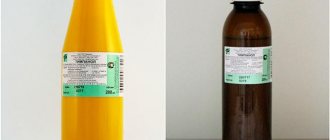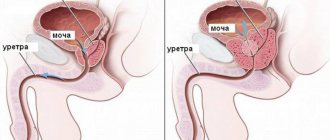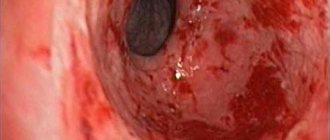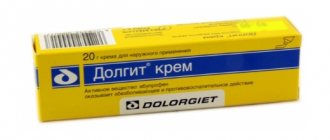Pharmacodynamics and pharmacokinetics
The active component is a derivative of dibenzazepine . The drug has antimanic, normothymic, antidiuretic (in patients with diabetes insipidus ), analgesic (for neuralgia ) effects.
The principle of action of the drug is based on the blockade of voltage-gated sodium channels, which causes inhibition of the process of occurrence of neuronal discharges, stabilization of the neuron membrane, which effectively leads to a decrease in synaptic conduction of impulses.
The drug prevents the re-formation of sodium-dependent action potentials in the structure of depolarized neurons.
Carbamazepine leads to a decrease in the release of glutamate (a neurotransmitter amino acid), which reduces the risk of developing an epileptic seizure . In children and adolescents with epilepsy , while taking the drug, there is a positive trend in the severity of depression and anxiety, as well as a decrease in aggressiveness and irritability.
The effect on psychomotor indicators and cognitive functions is dose-dependent and variable in each specific case.
With trigeminal neuralgia (essential, secondary), there is a decrease in the frequency of pain attacks.
For postherpetic neuralgia , post-traumatic paresthesia , tabes of the spinal cord - Carbamazepine helps relieve neurogenic pain.
During alcohol withdrawal, the drug can reduce the severity of the main symptoms (tremor of the limbs, increased excitability, gait disturbances), and increases the threshold of convulsive readiness.
In patients with diabetes mellitus, the drug reduces the feeling of heat, diuresis, and leads to rapid compensation of water balance.
The antimanic (antipsychotic) effect is registered after 7-10 days of therapy and develops as a result of inhibition of the metabolism of norepinephrine and dopamine .
The use of prolonged forms of carbamazepine makes it possible to achieve a stable concentration of the main substance in the blood, without recording “dips” and “peaks”.
Applications and dosages
for adults
The drug is taken orally, regardless of food, with a small volume of liquid.
The dosage of the medication is selected individually depending on the disease and clinical picture:
- Epilepsy. It is advisable to prescribe carbamazepine as a single drug. Therapy begins with a small daily dosage, which is then slowly increased until the optimal effect is achieved. If carbamazepine is added to an already ongoing antiepileptic therapy, this should be done gradually. The initial dosage can vary from 100 to 200 mg 1 or 2 times a day. It is gradually increased to 400 mg, the frequency of administration is 2-3 times a day. The highest daily dosage is 2 g.
- Neuralgia of the V and IX pairs of cranial nerves. Therapy should begin with a daily dosage of 200-400 mg, then gradually increase it, but not more than 200 mg per day until the pain goes away (usually up to 600-800 mg per day) and then reduce it to a minimum effective dosage. For patients in the older age group, the initial daily dosage should be 200 mg, taken 2 times.
- Pain due to diabetic neuropathy. A single dosage is 200 mg, the drug should be taken 2-4 times a day.
- Alcohol withdrawal syndrome. The dosage is selected depending on the clinical picture. The average dosage is 200 mg, the frequency of administration is 3 times a day. In severe cases, a single dosage can be 400 mg, daily - 1200 mg.
- Polydipsia and polyuria in diabetes insipidus. The average single dosage is 200 mg, the frequency of administration can vary from 2 to 3 times a day.
- Acute manic syndrome and maintenance therapy of bipolar disorders: the daily dosage can vary from 200 to 1600 mg, it should be taken 2-3 times. In acute cases, the dosage is increased quickly; in other cases, the dosage increase should be slow and small.
for children
For epilepsy in children under 5 years of age, the drug is prescribed in a daily dosage of 20 to 60 mg, then increased by 20-60 mg every 2 days. For patients over 5 years of age, the medication is prescribed at an initial daily dosage of 100 mg, then it is increased weekly by 100 mg. The maintenance daily dosage for children is 10-20 mg per kg of weight, it should be divided into 2-3 times.
For polyuria and polydipsia in diabetes insipidus, the treatment regimen is selected by the doctor individually depending on the age and weight of the child.
Indications for use of Carbamazepine
What are the tablets commonly used for? The drug is prescribed for epilepsy: mixed forms of seizures, generalized forms of seizures accompanied by tonic-clonic seizures, partial seizures .
The drug is used for idiopathic neuralgia of the glossopharyngeal nerve , for trigeminal neuralgia in patients with multiple sclerosis, for idiopathic trigeminal neuralgia.
What other indications for the use of Carbamazepine exist? The medication is recommended for use in acute manic states (combination therapy with antipsychotics, lithium preparations). The medicine is prescribed for diabetic neuropathy with painful symptoms, alcohol withdrawal syndrome (hyperexcitability, convulsions, anxiety, sleep disturbances), phasic affective disorders, diabetes insipidus of central origin, polydipsia of neurohormonal origin, polyuria.
The drug is prescribed for psychotic disorders (psychosis, schizoaffective and affective disorders, dysfunction of the limbic system, panic disorders), obsessive-compulsive disorders, Kluver-Bucy syndrome , senile dementia, tinnitus, dysphoria , anxiety, somatization, chorea, depression , for multiple sclerosis, tabes dorsalis, phantom pain, diabetic polyneuropathy , acute idiopathic neuritis, hemificial spasm, Ekbom's syndrome, post-traumatic neuralgia, neuropathy, for the prevention of migraine, for postherpetic neuralgia.
CARBAMAZEPINE
Synonyms
Actinerval, Apo-carbamazepine, Gen-carpaz, Zagretol, Zeptol, Carbadac, Carbalepsin retard, Carbamen, Carbapin, Carbatol, Carzepil, Mazepin, Stazepin, Storilat, Tegretol, Tegretol CR, Timonil, Finzepin ), Finlepsin, Finlepsin retard, Epial.
Composition and release form
Carbamazepine. Tablets (200 mg, 400 mg); retard tablets (100 mg, 200 mg, 300 mg, 400 mg, 600 mg); extended-release tablets (200 mg, 400 mg).
pharmachologic effect
Anticonvulsant; also has moderate antimanic, antidepressant and analgesic effects. In diabetes insipidus, it helps normalize water balance.
Pharmacokinetics
After oral administration, it is slowly but almost completely absorbed from the gastrointestinal tract and does not depend on food intake. Plasma protein binding in children is 55-59%. in adults - 70-80%. Penetrates the placenta and enters breast milk. Vd - 0.8-1.9 l/kg. T1/2 - 60-100 hours. Metabolized in the liver with the participation of the CYP3A4 isoenzyme. It is excreted in urine and feces unchanged and in the form of metabolites.
Indications
– Epilepsy: large, focal, mixed (including large and focal) epileptic seizures. Pain syndromes of predominantly neurogenic origin, including: essential trigeminal neuralgia, trigeminal neuralgia in multiple sclerosis, essential glossopharyngeal neuralgia. – Treatment and prevention of manic-depressive psychosis (as monotherapy or as part of combination therapy). – Psychotic disorders (including schizoaffective disorders, treatment-resistant schizophrenia and control disorder associated with dysfunction of the limbic system). – Withdrawal syndrome in patients with chronic alcoholism (as part of combination therapy). – Diabetes insipidus. – Diabetic neuropathy, accompanied by pain.
Application
The dose is set individually. For adults with epilepsy, treatment usually begins with the use of 200 mg (for elderly patients, the dose is 100 mg) of the drug 1-2 times / day. Then the doses are gradually increased until the optimal daily dose is obtained in the range of 800 mg-1.2 g.
For trigeminal neuralgia, treatment begins with a daily dose of 200-400 mg, which is divided into 2-3 doses, after 2-3 days the dose is increased by 100-200 mg/day, used for 7-10 days, then after improvement of the condition the dose is gradually reduced to a maintenance dose, which is used for a long time.
For children aged 4-12 months, the drug is prescribed at 100-200 mg/day; 2-3 years - 200-300 mg/day; 4-7 years - 300-500 mg/day; 8-14 years – 500 mg – 1 g/day; 15-18 years - 800 mg - 1.2 g / day. The indicated doses are divided into 2 doses.
Carbamazepine should not be used prophylactically during prolonged periods of remission of trigeminal neuralgia. During treatment, you should refrain from engaging in potentially hazardous activities that require increased attention, speed of mental and motor reactions, as well as drinking alcohol.
Pregnancy and lactation
The drug is prescribed with caution during pregnancy and lactation.
Side effect
Loss of appetite, nausea, vomiting, headache, drowsiness, ataxia, disturbance of accommodation. Rarely - leukopenia, thrombocytopenia, agranulocytosis, hepatitis, AR in the form of skin rash, dermatitis, edema, lymphadenopathy, interstitial nephritis, galactorrhea, arterial hypo- or hypertension, gynecomastia.
Carbamazepine should not be used to relieve common pain. The drug is not used for atypical or generalized petit mal seizures or myoclonic or atonic epileptic seizures.
Contraindications
Bone marrow diseases, atrioventricular block, hematological diseases; dysfunction of the liver, kidneys, cardiac activity, sodium metabolism; glaucoma, prostatitis; hypersensitivity to the drug, tricyclic antidepressants.
Overdose
Symptoms Depression of central nervous system functions, disorientation, drowsiness, agitation, hallucinations, coma, blurred vision, slurred speech, dysarthria, nystagmus, ataxia, dyskinesia, hyperreflexia (initially), later - hyporeflexia, convulsions, psychomotor disturbances, myoclonus, hypothermia; respiratory depression, pulmonary edema; tachycardia, arterial hypotension (sometimes increased blood pressure).
Intracardiac conduction disturbances with widening of the QRS complex on the ECG, loss of consciousness due to cardiac arrest, vomiting, slowing of intestinal motility; urinary retention, oliguria or anuria, fluid retention, edema (due to the effect of carbamazepine, reminiscent of the effect of ADH); hyponatremia, increased CPK activity, possible metabolic acidosis and hyperglycemia.
Treatment. Gastric lavage, taking activated carbon. Treatment measures should be aimed at maintaining the vital functions of the body and carried out in the intensive care unit with monitoring of cardiac activity and careful correction of electrolyte disorders.
For arterial hypotension, intravenous administration of dopamine or dobutamine is indicated; for seizures - benzodiazepines (for example, diazepam); for hyponatremia - fluid restriction and slow intravenous administration of 0.9% sodium chloride solution. Carboheme perfusion is effective; forced diuresis, hemodialysis and peritoneal dialysis are ineffective.
Interaction with other drugs
Carbamazepine may reduce the effectiveness of oral hormonal contraceptives (the use of other methods of contraception is recommended). Carbamazepine may reduce the effect of non-depolarizing muscle relaxants (eg, pancuronium).
The combined use of carbamazepine and some diuretics (hydrochlorothiazide, furosemide) can lead to clinically significant hyponatremia. Due to the induction of the monooxidase enzyme system of the liver, carbamazepine can reduce the content in the blood plasma and reduce the activity (up to the cessation of action) of the following drugs: clobazam, clonazepam, ethosuxemide, primidone, valproic acid, alprazolam, corticosteroids, cyclosporine, digoxin, doxycycline, felodipine, haloperidol, imipramine, methadone, oral contraceptives, theophylline, oral anticoagulants.
Carbamazepine can lead to an increase or decrease in the level of phenytoin and an increase in mephenytoin in the blood plasma. The following drugs can increase the level of carbamazepine in plasma: erythromycin, oleandomycin, josamycin, isoniazid, verapamil, diltiazem, dextropropoxyphene, viloxazine, fluoxetine, cimetidine, acetazolamide, danazol, desipramine, nicotinamide (in adults only in a large dose). Since increased plasma levels of carbamazepine may result in adverse reactions (eg, dizziness, somnolence, ataxia, diplopia), the dose and/or plasma concentrations of carbamazepine should be reconsidered.
The simultaneous use of carbamazepine and isoniazid may enhance the hepatotoxic effect of isoniazid. The following drugs can reduce plasma levels of carbamazepine: phenobarbital, phenytoin, primidone, irogabide, theophylline and possibly clonazepam, valproic acid and valpromide.
On the other hand, valproic acid and valpromide can increase the plasma levels of the pharmacologically active metabolite of carbamazepine, 10,11-epoxide. Isotretinoin may interfere with the bioavailability and/or clearance of carbamazepine and its pharmacologically active metabolite.
- 1950
Contraindications
Carbamazepine is not used for atrioventricular block, acute form of “intermittent” porphyria, impaired bone marrow circulation (leukopenia, anemia), intolerance to the main substance, hypersensitivity to tricyclic antidepressants . In case of active alcoholism, decompensated form of CHF, adrenal insufficiency, hypothyroidism , hypopituitarism , ADH hypersecretion syndrome, dilution hyponatremia, suppression of bone marrow hematopoiesis, increased intraocular pressure, prostatic hyperplasia, and pathology of the renal system, the medication is prescribed with caution, evaluating possible risks.
Side effects of Carbamazepine
The severity of the side effect is dose-dependent.
Nervous system: accommodation paresis, headaches, asthenia, ataxia, dizziness, rarely observed abnormal involuntary movements (tics, dystonia, tremor), paresthesia, peripheral neuritis , choreoathetoid disorders, speech disorders, oculomotor disorders, orofacial dyskinesias, nystagmus, symptoms of paresis, myasthenia gravis.
Mental areas: activation of psychosis, disorientation , agitation, aggressive behavior, anxiety, decreased appetite, depression, visual hallucinations, auditory hallucinations . Allergic reactions: skin itching, erythroderma, urticaria , photosensitivity, Lyell's syndrome, Stevens-Johnson syndrome.
Hematopoietic organs: aplastic anemia , leukocytosis, thrombocytopenia, reticulocytosis, hemolytic anemia, lymphadenopathy. Digestive tract: pancreatitis , stomatitis , glossitis , epigastric pain, stool disorders, liver failure, jaundice, granulomatous hepatitis, increased liver enzymes.
Cardiovascular system: exacerbation of coronary artery disease, worsening of CHF, atrioventricular block with fainting, bradycardia, instability of blood pressure, impaired intracardiac conduction, arrhythmia, thromboembolic syndrome , thrombophlebitis. Metabolism, endocrine system: hyperprolactinemia , decreased L-thyroxine levels, hyponatremia, weight gain, swelling, fluid retention in the body, hypercholesterolemia, osteomalacia.
Genitourinary system: frequent urination, disturbances in the renal system, interstitial nephritis, decreased potency, hematuria, oliguria, albuminuria . Musculoskeletal system: convulsions, myalgia, arthralgia.
Sense organs: changes in the perception of pitch, hypoacusia, hyperacusia, tinnitus, hearing impairment, conjunctivitis, lens opacification, impaired taste perception. Increased sweating, acne , purpura, alopecia, skin pigmentation disorders, and hirsutism are also possible.
Side effects[ | ]
Hyperhidrosis, double vision, hypersomnia, stupor, stomach upset, flatulence.
The drug is usually well tolerated [ source not specified 664 days
]. In some cases, loss of appetite, nausea, and rarely vomiting, headache, drowsiness, ataxia, and disturbance of accommodation are possible. A decrease or disappearance of side effects occurs when the drug is temporarily stopped or the dose is reduced. There is also evidence of allergic reactions, leukopenia, thrombocytopenia, agranulocytosis, hepatitis, skin reactions, and exfoliative dermatitis. If these reactions occur, stop taking the drug [12].
The possibility of the occurrence of mental disorders in patients with epilepsy who have undergone treatment with carbamazepine should be taken into account.
During treatment with carbamazepine, it is necessary to systematically monitor the blood picture. It is not recommended to prescribe the drug during pregnancy[12].
Carbamazepine causes harmful side effects ranging from 33-50%, although most of these side effects are mild, transient and reversible. Carbamazepine hyponatremia is a well-described side effect and may be responsible for some of the other side effects of carbamazepine. Numerous clinical studies have examined possible risk factors such as age, carbamazepine dose (level), polypharmacy, and carbamazepine dose (level) and polypharmacy (but not age) have been identified as predisposing risk factors for hyponatremia. The mechanism of the antidiuretic effect of carbamazepine is not yet clear. The most likely mechanism involves changes in either the sensitivity or the site of the osmoreceptor[17].
Carbamazepine interferes with the absorption of biotin (vitamin H) in the gastrointestinal tract, which is of great importance for the growth process and absorption of fats, carbohydrates and proteins. A lack of biotin in the body can lead to dangerous complications, such as neurological disorders, and sometimes death[18]:156.
Carbamazepine tablets, instructions for use (Method and dosage)
The drug is taken orally with a sufficient amount of water. Long-acting tablets (Carbamazepine Retard) are not chewed, swallowed whole, twice a day.
For epilepsy, the drug is prescribed, whenever possible, as monotherapy. It is recommended to start treatment with small doses with a gradual increase in dosage, which allows you to achieve optimal results. The initial dosage for adults is 100-200 mg 1-2 times a day, gradually increasing the amount of medication.
Trigeminal neuralgia: the first day of therapy – 200-400 mg, with a gradual increase to 400-800 mg per day, then the drug Carbamazepine is gradually discontinued.
The initial dosage for pain syndrome of neurogenic origin is 100 mg twice a day, with an increase in dose every 12 hours until pain subsides. The maintenance dosage is 200-1200 mg per day, divided into several doses.
The average dosage for alcohol withdrawal syndrome is 200 mg three times a day; in severe cases, the dose is increased to 400 mg three times a day.
In the first days of therapy, it is recommended to additionally prescribe chlordiazepoxide, clomethiazole and other sedative-hypnotics.
For diabetes insipidus, adults are prescribed 200 mg 2-3 times a day.
For diabetic neuropathy with pain, 200 mg is prescribed 2-4 times a day.
Prevention of schizoaffective and affective psychoses: 600 mg for 3-4 doses per day.
The daily dose for bipolar, affective disorders, manic states is 400-1600 mg.
Instructions for use of Carbamazepine Acri are similar.
Dosage regimen[ | ]
Main[ | ]
Prescribed orally (during meals) or after meals for adults, starting with 0.1 g (1/2 tablet) 2-3 times a day, gradually increasing the dose to 0.4-1.2 g (2-6 tablets) per day. day[12].
The average daily dose for children is 20 mg per 1 kg of body weight, that is, on average, up to 1 year of age from 0.1 to 0.2 g per day; from 1 year to 5 years 0.2-0.4 g; from 5 to 10 years - 0.4-0.6 g; from 10 to 15 years - 0.6-1 g per day [21].
With hyperkinesia[ | ]
There is evidence of the effectiveness of the drug in a number of cases in patients with various hyperkinesis. The initial dose of 0.1 g was gradually (after 4-5 days) increased to 0.4-1.2 g per day. After 1-4 weeks. the dose was reduced to 0.1-0.2 g per day, then the same doses were prescribed daily or every other day for 1-2 weeks[21].
For trigeminal neuralgia[ | ]
Carbamazepine is prescribed for trigeminal neuralgia, starting with 0.1 g 2 times a day, then the dose is increased by 0.1 g per day if necessary to 0.6-0.8 g (in 3-4 doses). The effect usually occurs 1-3 days after the start of treatment. After the pain disappears, the dose is gradually reduced (to 0.2-0.1 g per day). The drug is prescribed for a long time; If the drug is discontinued prematurely, the pain may recur. Currently, carbamazepine is considered one of the most effective drugs for this pathology[21].
Overdose
It manifests itself as disturbances in the functioning of the respiratory, cardiovascular and nervous systems.
Sense organs, nervous system: dysarthria , fainting, disorientation, nystagmus, hyporeflexia, myoclonus, psychomotor disorders, convulsions, mydriasis, hypothermia , visual disturbances, hallucinations, drowsiness, agitation.
Cardiovascular system: cardiac arrest, intraventricular conduction disturbance, tachycardia, blood pressure .
Pulmonary edema, respiratory depression, vomiting, nausea, decreased colonic motility, delayed evacuation of food from the stomach, hyponatremia , fluid retention, anuria , oliugria, metabolic acidosis , hyperglycemia are also noted.
A specific antidote has not been developed. Treatment of overdose is carried out syndromic.
Side effects
Sometimes discontinuation of the drug is required due to unwanted reactions of the body. The following side effects usually occur with carbamazepine:
- Nervous system: Mental disorders;
- Hallucinations;
- Outbursts of aggression;
- Tremor;
- Neuralgia;
- Signs of paresthesia (goose bumps, numbness and tingling);
- Weakening of muscles (paresis);
- Migraine, headache;
- Double images before the eyes (diplopia);
- Dizziness;
- Drowsiness;
- Disorders associated with the movement of the eyeballs;
- General fatigue;
- Impaired coordination of movements;
- Nystagmus (eye fluctuations).
- Cardiovascular system: Impaired conduction of intracardiac vessels;
- Heart failure;
- Pressure surges;
- Heart rhythm disturbances;
- Thrombophlebitis, which is inflammation of the vein wall with the formation of a blood clot.
- Abnormal bowel movements (constipation, diarrhea);
- Excessive sweating;
- Dyspnea;
Interaction
Metabolism of the drug is carried out using cytochrome CYP3A4 . When administered simultaneously with inhibitors of this cytochrome, an increase in its concentration is observed, and, accordingly, the severity of side effects increases. Cytochrome inducers accelerate metabolic processes, reduce the level of drug concentration in the blood, reducing the severity of its therapeutic effect.
The concentration of the drug in the blood increases: Nicotinamide , Verapamil , Cimetidine , fluvoxamine , Fluoxetine , Viloxazine , Dextropropoxyphene , Felodipine , Diltiazem , acetazolamide , Desipramine , Danazol , Trefenadine , macrolides ( troleandomycin , Clarithromycin , Josamycin , Erythromycin cin ), azoles ( Fluconazole , Itraconazole , Ketoconazole ), ritonavir , propoxyphene , isoniazid , Loratadine .
Phenobarbital , Cisplatin , Rifampicin , Theophylline , Primidone , Phenytoin , valproic acid , Valpromide , Doxorubicin , Cisplatin - reduce the concentration of the drug in the blood.
When the drug is combined with maprotiline psychosis and confusion may occur .
special instructions
Monotherapy for patients with epilepsy begins with small dosages with a gradual increase in the amount of the drug to achieve the desired effect. In combination therapy, it is advisable to determine the plasma concentration of carbamazepine to select the optimal dosage. When the drug is abruptly discontinued, epileptic seizures . If it is necessary to discontinue carbamazepine, they try to transfer the patient to another antiepileptic drug. During therapy, monitoring of the performance of the liver system and blood condition is required. Carbamazepine has a weak anticholinergic effect , which requires constant monitoring of intraocular pressure. The drug can reduce the effectiveness of oral contraceptives, which requires the use of additional methods to protect against pregnancy.
MNN: Carbamazepine.
Reviews of Carbamazepine
There are few reviews on forums about the drug used for medicinal purposes. Basically, opinions are left on the effect of the drug as a drug.
When a medicine is used in the treatment of various types of depressive conditions and mental disorders, opinions are expressed about its weak effectiveness in comparison with more modern analogues, which at the same time have fewer side effects. In the treatment of trigeminal neuralgia, the medication is considered ineffective.
Insomnia may also be a consequence of using the drug.
Reviews of Carbamazepine Acri are similar.
Carbamazepine price, where to buy
The price of Carbamazepine is 55 rubles per package of 50 tablets of 200 mg.
- Online pharmacies in RussiaRussia
- Online pharmacies in UkraineUkraine
- Online pharmacies in KazakhstanKazakhstan
ZdravCity
- Carbamazepine tablets 0.2g 50 pcs. JSC Obolenskoe farm.
enterprise 191 rub. order - Carbamazepine tablets 200 mg 40 pcs. JSC ALSI Pharma
67 RUR order
- Carbamazepine tablets 200 mg 50 pcs. Welfarm LLC
RUB 193 order
- Carbamazepine tablets 200 mg 50 pcs. JSC Sintez
72 RUR order
Pharmacy Dialogue
- Carbamazepine tablets 200 mg No. 40 Alsi Pharm
65 rub. order
Europharm* 4% discount using promo code medside11
- Carbamazepine welpharm 200 mg 50 tablets welpharm LLC
67 RUR order
- Carbamazepine 200 mg 40 tabALSI Pharma ZAO
69 RUR order
show more
Pharmacy24
- Carbamazepine-Astrapharm 200 mg N20 tablets TOV Astrapharm, Ukraine
21 UAH order - Carbamazepine-FS 200 mg No. 50 tablets Pharma Start TOV, Ukraine
35 UAH order
- Carbamazepine-Darnitsa 0.2 g No. 20 tablets PrAT” Pharmaceutical company “Darnitsa”, Ukraine
17 UAH order
- Carbamazepine-FS 200 mg No. 20 tablets Pharma Start TOV, Ukraine
18 UAH order
- Carbamazepine 200 mg N20 tablets PrAT "Technolog", Uman, Cherkasy region, Ukraine
18 UAH order
PaniPharmacy
- Carbamazepine tablet 0.2g No. 20
18 UAH order
- CARBAMAZEPINE tablets Carbamazepine tablets. 200 mg No. 20 Ukraine, Health LLC
18 UAH order
- CARBAMAZEPINE tablets Carbamazepine tablets. 0.2g No. 50 Ukraine, Tekhnolog ChAO
38 UAH order
- Carbamazepine tablets Carbamazepine tablets. 0.2g No. 20 Ukraine, Darnitsa ChAO
21 UAH order
- CARBAMAZEPINE tablets Carbamazepine-FS tablet. 200 mg No. 20 Ukraine, Pharma Start LLC
22 UAH order
show more








